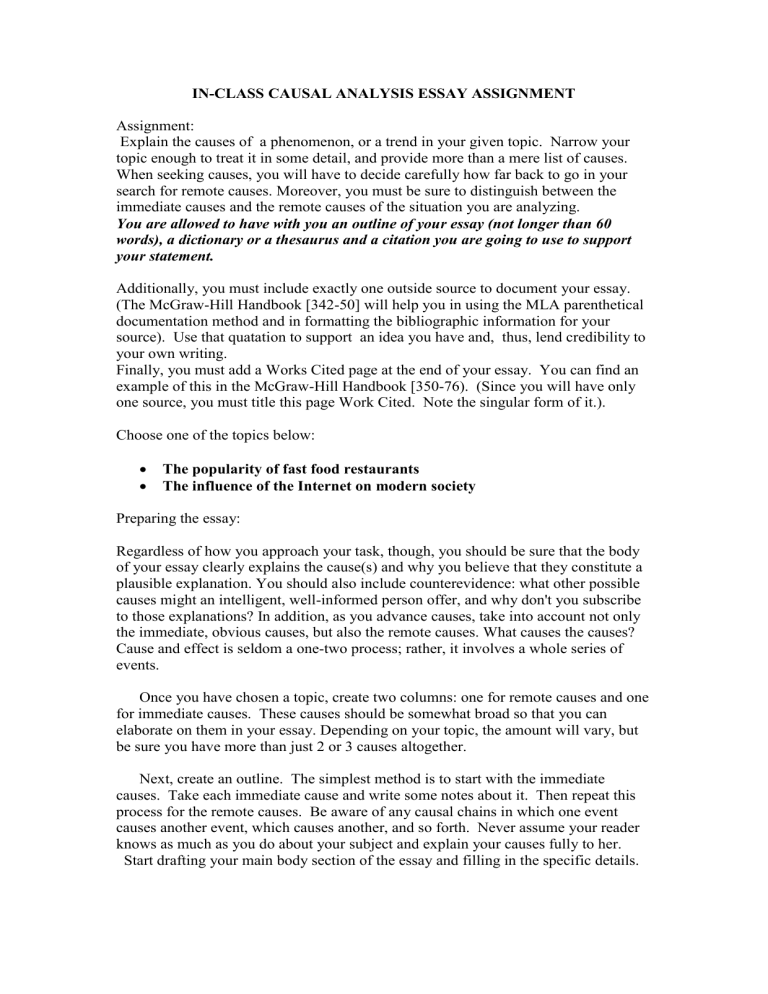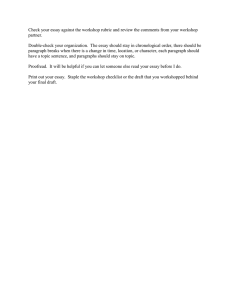Causal analysis essay.doc

IN-CLASS CAUSAL ANALYSIS ESSAY ASSIGNMENT
Assignment:
Explain the causes of a phenomenon, or a trend in your given topic. Narrow your topic enough to treat it in some detail, and provide more than a mere list of causes.
When seeking causes, you will have to decide carefully how far back to go in your search for remote causes. Moreover, you must be sure to distinguish between the immediate causes and the remote causes of the situation you are analyzing.
You are allowed to have with you an outline of your essay (not longer than 60 words), a dictionary or a thesaurus and a citation you are going to use to support your statement.
Additionally, you must include exactly one outside source to document your essay.
(The McGraw-Hill Handbook [342-50] will help you in using the MLA parenthetical documentation method and in formatting the bibliographic information for your source). Use that quatation to support an idea you have and, thus, lend credibility to your own writing.
Finally, you must add a Works Cited page at the end of your essay. You can find an example of this in the McGraw-Hill Handbook [350-76). (Since you will have only one source, you must title this page Work Cited. Note the singular form of it.).
Choose one of the topics below:
The popularity of fast food restaurants
The influence of the Internet on modern society
Preparing the essay:
Regardless of how you approach your task, though, you should be sure that the body of your essay clearly explains the cause(s) and why you believe that they constitute a plausible explanation. You should also include counterevidence: what other possible causes might an intelligent, well-informed person offer, and why don't you subscribe to those explanations? In addition, as you advance causes, take into account not only the immediate, obvious causes, but also the remote causes. What causes the causes?
Cause and effect is seldom a one-two process; rather, it involves a whole series of events.
Once you have chosen a topic, create two columns: one for remote causes and one for immediate causes. These causes should be somewhat broad so that you can elaborate on them in your essay. Depending on your topic, the amount will vary, but be sure you have more than just 2 or 3 causes altogether.
Next, create an outline. The simplest method is to start with the immediate causes. Take each immediate cause and write some notes about it. Then repeat this process for the remote causes. Be aware of any causal chains in which one event causes another event, which causes another, and so forth. Never assume your reader knows as much as you do about your subject and explain your causes fully to her.
Start drafting your main body section of the essay and filling in the specific details.
Your essay needs to be written in the third person point of view. Avoid using the second person point of view.
Organizing and Structuring the Essay:
1. Introductory Paragraph:
Begin your essay by arousing the audience’s interest in the introductory paragraph.
This is the paragraph that must clearly establish the subject of your essay and that must identify the purpose for writing the essay. In this assignment, your purpose is to explain what has given rise to a particular phenomenon.
Create a thesis that is one sentence long and that appears in the very last sentence of the introductory paragraph. When you formulate a thesis statement, you will want to be sure that it clarifies the relationships among the specific causes or effects you will discuss. This thesis statement should tell your readers three things: the points you plan to consider, the position you will take, and whether your emphasis is on causes, effects, or both. Your thesis statement may also indicate explicitly or implicitly the cause or effect you consider most important and the order in which you will treat your points.
2. Main Body section:
In the main body of your essay, take your outline you developed above and begin writing the paragraphs that you can build from your carefully detailed notes.
In the main body of your essay, create a paragraph for each of your causes, whether it is a remote or an immediate cause. Each paragraph, though, should start off with a topic sentence that indicates the next cause you will be explaining. Consider how to order the main body paragraphs. For example, within the immediate causes section, you might arrange the 2-3 paragraphs by the most serious reasons to the least serious causes. You will have several main body paragraphs, but the number will vary depending on your subject.
Remember to add the analysis part to each of the paragraphs.
You cannot merely write about what causes something to happen; you have to explain why.
Don't stray from your topic; stay focused.
You must use transitions between paragraphs to signal that you are writing about a new cause, whether it is a remote or an immediate cause. Your objective is to link the paragraphs together smoothly.
3. Conclusion Paragraph: Your conclusion paragraph should clearly bring the essay to a close. While you do not need to restate each of the various causes, you might want to reiterate your essay's purpose that was stated in the introductory paragraph.
You might want to predict what the future holds if the event you are examining is not the end result of some previous events. What are the implications of the event now that it has occurred?
Audience: academic; assume they’re not knowledgeable about the event you are writing on.
Purpose: to practice the skill of accurately explaining/ analyzing why one event causes another.
Writing Mode: narration, illustration, causal analysis.
Point of view: The point of view for this essay will be in the third person, so you will be using the “he/she/it/they pronouns frequently. You must consistently maintain this point of view.
Standard American English (SAE): Remember, your paper must follow the basic conventions of standard American written English (correct mechanics, usage, grammar, spelling, punctuation, sentence structure, etc.).





